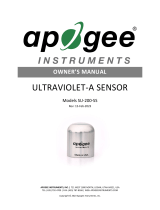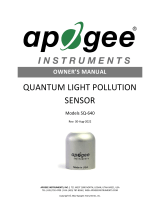Sensor Calibration
Although the MO-200 reports the relative percent oxygen in air, it will respond to absolute oxygen concentration.
Changes in barometric pressure and temperature cause changes in absolute oxygen concentration, and as a result,
changes in sensor signal output. This causes apparent changes in relative oxygen concentration, even though the
relative amount of oxygen remains constant. Changes in absolute humidity (water vapor pressure of air) cause
changes in absolute and relative oxygen concentration, as water vapor molecules displace and dilute oxygen
molecules. Therefore, the MO-200 oxygen meters are not calibrated at the factory and must be calibrated by the
user. It is recommended to calibrate the MO-200 before taking a series of measurements, or under conditions
where drastic changes occur in pressure, temperature, or humidity during subsequent measurements.
Because the MO-200 is easily calibrated to ambient atmospheric conditions, the following information regarding
the effects of barometric pressure, temperature, and humidity on the MO-200 may not be pertinent to all users. It
is provided as a reference for users who wish to make the corrections without recalibrating the meter.
Effect of Barometric Pressure on Oxygen Concentration
The ideal gas law, equation (1), shows that absolute gas concentration increases by 0.987 % at sea level for every 1
kPa increase in pressure (1 kPa / 101.325 kPa = 0.00987). For a sensor that measures absolute gas concentration,
but is calibrated to read out in relative units, a 1 kPa pressure increase at sea level results in an apparent oxygen
increase of 0.207 % (0.00987 * 20.95 % = 0.207 %) and an apparent relative oxygen concentration of 21.157 %.
Relative gas concentration didn’t really increase, but absolute concentration, which is what sensors measure, did
change. This shows up as an apparent change in relative concentration.
Due to lower barometric pressure at higher elevations, the percentage increase in absolute gas concentration per
kPa increases with elevation. For example, at an elevation of 1378 m (Logan, Utah), barometric pressure is
approximately 86 kPa and absolute gas concentration increases by 1.16 % for every 1 kPa increase in pressure (1
kPa / 86 kPa = 0.0116). Again, for a sensor that measures absolute gas concentration, but is calibrated to read out
in relative units, this results in an apparent oxygen increase. In this example, 0.243 % for every 1 kPa increase in
barometric pressure (0.0116 * 20.95 % = 0.243 %) and an apparent relative oxygen concentration of 21.193 %.
A barometric pressure correction should be applied to all oxygen sensors that are calibrated to read relative
oxygen concentration. The equation to correct relative oxygen measurements for barometric pressure at any
elevation is:





























